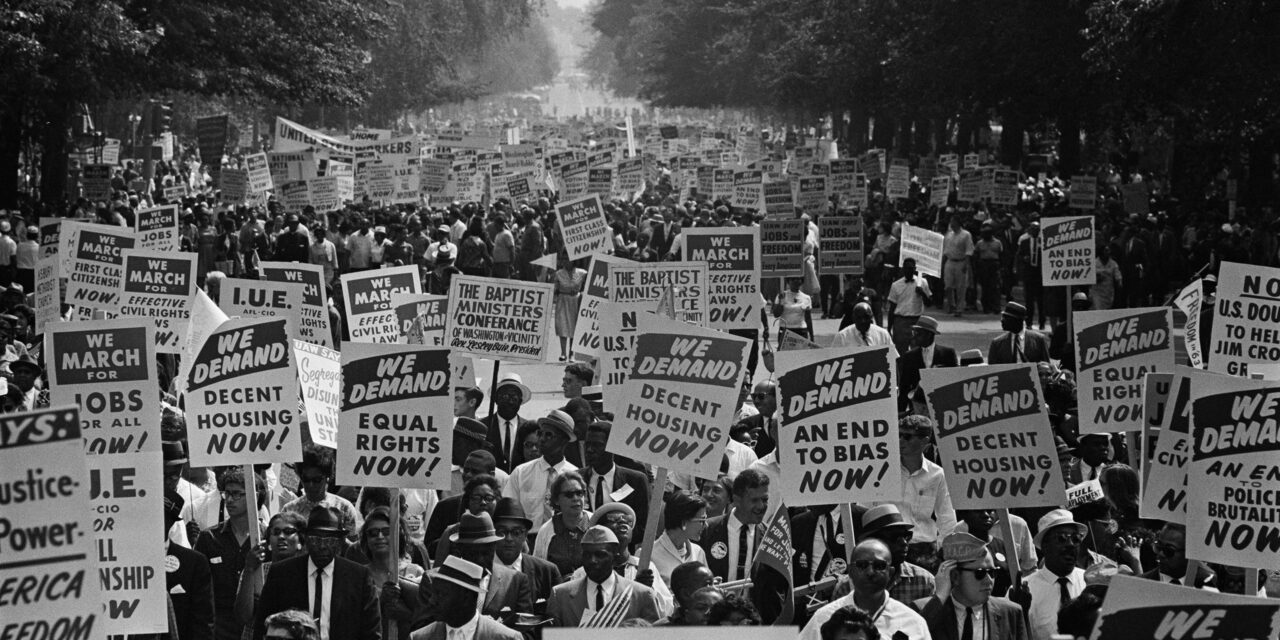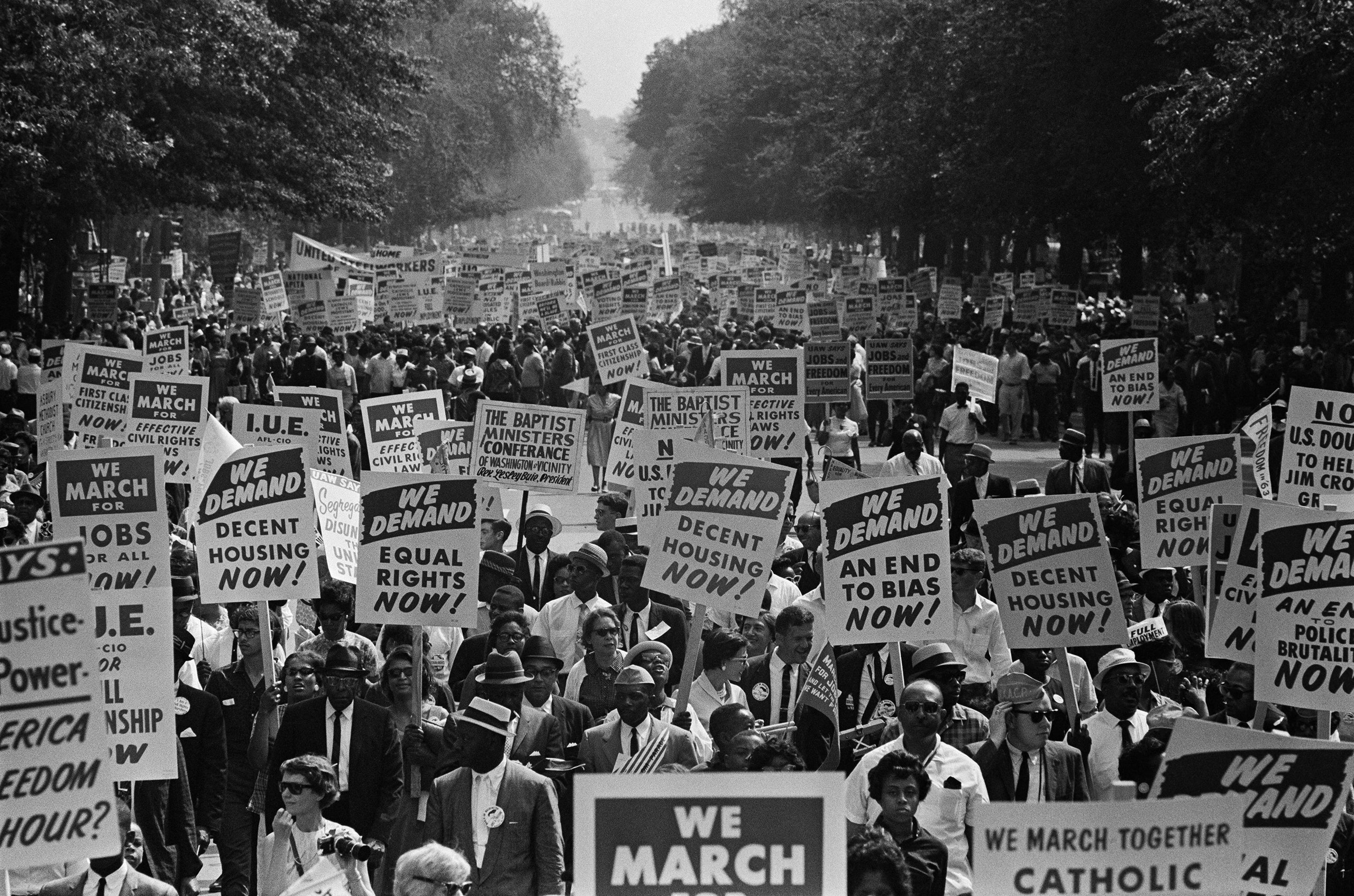The Disciplining Power of Disappointment
At the center of the American national narrative is progress. The supposed ongoing propulsion into the future is not only about direction or momentum; it is also suffused with moral meaning. Our progress, as promulgated by its boosters, has been toward a more perfect union. The historic promises of personal liberty, democratic self-rule based in law and not monarchical declaration, and an expansive frontier were the first emblems of said perfect union. Untold growth and endless wealth anchored this notion of forward movement in the twentieth century as the American Dream, with its promises of unimpeded social mobility.
As is almost always the case, the national narrative is told from the perspective of the settler, the slave master, the disciple of the American Century. The dark realities of expansion, buttressed by the backbreaking labor of enslaved people, are the quiet parts of this story. If optimism is the disposition of the victor, then what is the outlook of the victim or survivor of conquest and domination?
For Sara Marcus, an assistant professor of English at the University of Notre Dame, it is disappointment. In a new book, “Political Disappointment,” Marcus describes the titular emotion as “untimely desire” or “a longing for fundamental change that outlasts a historical moment when it might have been fulfilled.” The desire persists even when its fulfillment has been irretrievably delayed. Marcus shows the ways in which Black activists and writers, in particular, have continued to express their political desires. In doing so, she draws our attention to the centrality of disappointment in American political life. The failures of political movements—whether to achieve a multiracial democracy or a social revolution centered on the Black working class or women’s liberation—threw off the timing of progress.
Marcus is also challenging the assumption that disappointment is bad or should be avoided in politics. On the left, she writes, we constantly avert the bad news of failure by finding its silver lining: that “we’d shown how scared the bosses were of our cause, or we’d trained new activists or we’d gotten people talking about our issues.” There is a fear of finality with failure, whereas Marcus is pulling her readers toward the continuity of desire for change.
Her book also contributes to the ongoing debates over the authorship of the country’s identity. Upon whose experience do we base notions of gradual betterment? Whose experience counts? Marcus forgoes the continued argument concerning the nation’s origin story: is its true founding date 1776 or is it 1619? Instead, she looks to the failure of Reconstruction as the beginning of a century of disappointment, because of what was possible, perhaps even expected, but eventually lost. Reconstruction marked the nation’s first attempt at developing a multiracial democracy, by way of ending slavery and the military occupation of the South, allowing newly minted Black citizens to participate in local, state, and national politics. But it was quickly thwarted, as W. E. B. Du Bois writes in “Black Reconstruction”: “The slave went free; stood a brief moment in the sun; then moved back again toward slavery.”
Marcus sees Black Americans as quintessentially disappointed, because of the enduring gap between what has been promised and what has occurred and what has been lived. The Black artists and writers whose work she considers include Huddie Ledbetter, Audre Lorde, and Marlon Riggs. But, for Marcus, Du Bois’s classic “The Souls of Black Folk,” and its articulation of the burden of racism and the color line, defines the existential disappointment of a new century. As Du Bois famously announced at the onset of “Souls,” “The Nation has not yet found peace from its sins; the freedman has not yet found in freedom his promised land. Whatever of good may have come in these years of change, the shadow of a deep disappointment rests upon the Negro people—a disappointment all the more bitter because the unattained ideal was unbounded save by the simple ignorance of a lowly people.” The profundity of this disappointment is only recognizable because of the exulting possibility that Reconstruction held.
Marcus tracks what she describes as the transcriptive practices of these artists and writers, including “both records and scores, remains of past performances and invitations to future ones.” To this end, Du Bois’s rhapsody on sorrow songs, in the final chapter of “Souls,” captures the essence of her project. The spirituals, which arose from the misery of slavery, were then resurrected, by the Fisk Jubilee Singers, from the postbellum period into the turn of the century. They embodied the sadness of the enslaved, but their survival and then embellishment by choral singers demonstrated new possibilities. Du Bois’s capture of these songs and their choral arrangement on the page and, indeed, as an epigraph for each chapter of the book becomes evidence, Marcus writes, of “audible alliances that erratically coalesce, fade out, and go on reverberating.”
Marcus, who is also a musician and the author of “Girls to the Front: The True Story of the Riot Grrrl Revolution,” writes with reverence and clarity about the sonic qualities of struggle. Disappointment may be reprised as a renewed political effort, or it may find new expression, as Marcus points out, with Ledbetter, more popularly known as Lead Belly, incorporating a breathy exhalation into his performances, perhaps to express disappointment with the Communist Party’s abandonment of class struggle. Here, Marcus presents a critical intervention, questioning the Communist Party’s turn to the Popular Front in the nineteen-thirties, in an attempt to proselytize Communism as, in the words of one slogan, “twentieth-century Americanism.” It has become conventional among some U.S. historians to celebrate the C.P.’s turn toward the Popular Front as evidence of the widespread appeal of radical ideas. It is true that the C.P. grew much more significantly during the thirties, but this growth was made possible by downplaying its earlier radical suppositions. As Marcus points out, “The Popular Front era’s new openness to coalition building led to a watering down of the party’s antiracist priorities. . . . The task of organizing workers to lead the revolution and create authentically working-class revolutionary culture was no longer as important as attracting a wide range of people to the party.”
Disappointment is also the grist found among feminists—both women of color and white women—when it became clear, by the nineteen-eighties, that the political climate had deteriorated in ways that foreclosed the possibility of women’s liberation. The movement did not just collapse upon itself in disappointment of a missed opportunity. Instead, women found new means to advance their struggles—in Marcus’s account, mainly by moving from simple demands for “voice” (inclusion or basic measures of representation) toward an emphasis on visibility (the arresting power of both seeing and being seen). Turning away from voice toward visibility was a powerful shift for women more generally, but especially for Black women, who were simultaneously hypervisible and invisible in caustic debates over social-welfare spending and other discussions controlled by the right. Marcus points to Audre Lorde’s poem “Afterimages” and writes, “this practice of seeing transforms images of pain and degradation into sustenance for the seeing subject.” Marcus goes on to quote Lorde’s observation of the ways in which these small shifts hold meaning: “one of the most basic Black survival skills is the ability to change, to metabolize experience, good or ill, into something that is useful, lasting, effective.”
Marcus describes the twentieth century as defined by political disappointment. I wondered what part of this can also be understood as a process of radicalization. For example, Marcus examines the March Against Fear, in Mississippi, in 1966, when the activist Stokely Carmichael challenged the authority of Martin Luther King, Jr., by calling for “Black Power” over the old familiar civil-rights song “We Shall Overcome.” Marcus describes how marchers in conflict over slogans, which embodied deeper conflict over the direction of the movement, came together by agreeing to continue the march in silence. Marcus suggests that this compromise foreshadowed the potential of solidarity or new forms of coalition. But it also pointed to a deepening inability to overcome differences over the strategies that would propel the movement forward. Silence may also be the resolve to “agree to disagree.”
This raises a question of whether all of Marcus’s examples work in the same way. The defeat of Reconstruction by white supremacists and the defeat of the Communist Party at the hands of the state’s carefully instigated anti-Communist hysteria seem more consequential than the debates that ensue when radicals break from the narrow confines of liberalism—exemplified here by “freedom now” and the insistence on the power of inclusion among feminists. The collapse of Reconstruction and the McCarthyite subjugation of the left fostered the conditions of conflict that were to erupt within the civil-rights movement and the feminist movement. The former were historic failures; the latter, internal pivots. Which may be another way of saying that one set of disappointments had significantly more impact than the others. What may tie them together for Marcus is that, in each of her examples of twentieth-century disappointment, “there breathes some hope,” by which she means is that there is “curiosity toward and unknowing about what might come next, and an awareness of history as changeability: an understanding that the passage of time and the workings of historical forces would bring about conditions that were somehow different from the present.”
Of course, disappointment has continued into the twenty-first century. Indeed, the failure to create new solutions to old problems has engendered even more profound disappointment today. There were great hopes for the Obama Presidency, but its failures laid the foundation for Occupy Wall Street, Black Lives Matter, and #MeToo. They may have also deeply wounded the political project of liberalism. For core constituencies of the Democratic Party, the Obama campaign was a last gasp of hope that our electoral system could produce change.
The election of Donald Trump showed that disappointment could cut both ways. Through the “unfulfilled desire” of largely young Black, white, and Latino people, new solidarities were forged, contributing to the sweeping political protests during the summer of 2020. The protests produced new understandings of inequality in U.S. society, with the phrase “systemic racism” entering mainstream discourse as a way to make sense of the disparities that shape much of Black life in the country. Today, strikes, abortion-rights demonstrations, and continued protests against police violence represent the continuity of desire for social transformation even after the debilitating disappointment of Trump and the deflating relief of the Biden Presidency. This is, at least, part of the generative possibility that Marcus is searching for in her examination of disappointment as a political expression. ♦






